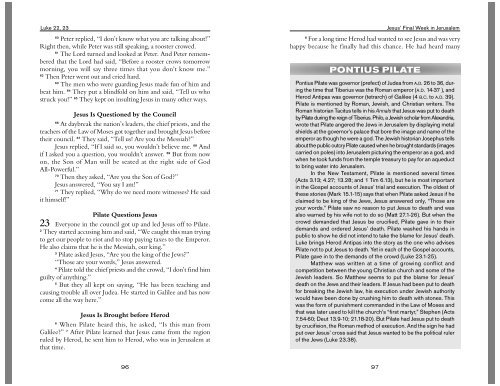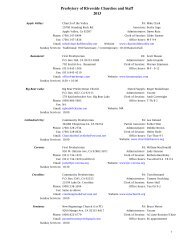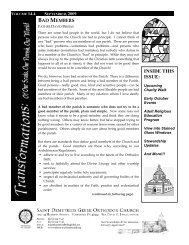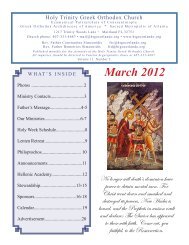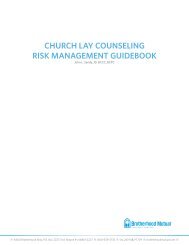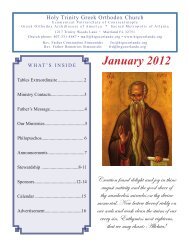The Life of the Christ - ForMinistry
The Life of the Christ - ForMinistry
The Life of the Christ - ForMinistry
Create successful ePaper yourself
Turn your PDF publications into a flip-book with our unique Google optimized e-Paper software.
Luke 22, 23<br />
60 Peter replied, “I don’t know what you are talking about!”<br />
Right <strong>the</strong>n, while Peter was still speaking, a rooster crowed.<br />
61 <strong>The</strong> Lord turned and looked at Peter. And Peter remembered<br />
that <strong>the</strong> Lord had said, “Before a rooster crows tomorrow<br />
morning, you will say three times that you don’t know me.”<br />
62 <strong>The</strong>n Peter went out and cried hard.<br />
63 <strong>The</strong> men who were guarding Jesus made fun <strong>of</strong> him and<br />
beat him. 64 <strong>The</strong>y put a blindfold on him and said, “Tell us who<br />
struck you!” 65 <strong>The</strong>y kept on insulting Jesus in many o<strong>the</strong>r ways.<br />
Jesus Is Questioned by <strong>the</strong> Council<br />
66 At daybreak <strong>the</strong> nation’s leaders, <strong>the</strong> chief priests, and <strong>the</strong><br />
teachers <strong>of</strong> <strong>the</strong> Law <strong>of</strong> Moses got toge<strong>the</strong>r and brought Jesus before<br />
<strong>the</strong>ir council. 67 <strong>The</strong>y said, “Tell us! Are you <strong>the</strong> Messiah?”<br />
Jesus replied, “If I said so, you wouldn’t believe me. 68 And<br />
if I asked you a question, you wouldn’t answer. 69 But from now<br />
on, <strong>the</strong> Son <strong>of</strong> Man will be seated at <strong>the</strong> right side <strong>of</strong> God<br />
All-Powerful.”<br />
70 <strong>The</strong>n <strong>the</strong>y asked, “Are you <strong>the</strong> Son <strong>of</strong> God?”<br />
Jesus answered, “You say I am!”<br />
71 <strong>The</strong>y replied, “Why do we need more witnesses? He said<br />
it himself!”<br />
Pilate Questions Jesus<br />
23 Everyone in <strong>the</strong> council got up and led Jesus <strong>of</strong>f to Pilate.<br />
2 <strong>The</strong>y started accusing him and said, “We caught this man trying<br />
to get our people to riot and to stop paying taxes to <strong>the</strong> Emperor.<br />
He also claims that he is <strong>the</strong> Messiah, our king.”<br />
3 Pilate asked Jesus, “Are you <strong>the</strong> king <strong>of</strong> <strong>the</strong> Jews?”<br />
“Those are your words,” Jesus answered.<br />
4 Pilate told <strong>the</strong> chief priests and <strong>the</strong> crowd, “I don’t find him<br />
guilty <strong>of</strong> anything.”<br />
5 But <strong>the</strong>y all kept on saying, “He has been teaching and<br />
causing trouble all over Judea. He started in Galilee and has now<br />
come all <strong>the</strong> way here.”<br />
Jesus Is Brought before Herod<br />
6 When Pilate heard this, he asked, “Is this man from<br />
Galilee?” 7 After Pilate learned that Jesus came from <strong>the</strong> region<br />
ruled by Herod, he sent him to Herod, who was in Jerusalem at<br />
that time.<br />
96<br />
8 For a long time Herod had wanted to see Jesus and was very<br />
happy because he finally had this chance. He had heard many<br />
PONTIUS PILATE<br />
97<br />
Jesus’ Final Week in Jerusalem<br />
Pontius Pilate was governor (prefect) <strong>of</strong> Judea from A.D. 26 to 36, during<br />
<strong>the</strong> time that Tiberius was <strong>the</strong> Roman emperor (A.D.14-37 ), and<br />
Herod Antipas was governor (tetrarch) <strong>of</strong> Galilee (4 B.C.to A.D. 39).<br />
Pilate is mentioned by Roman, Jewish, and <strong>Christ</strong>ian writers. <strong>The</strong><br />
Roman historian Tacitus tells in his Annals that Jesus was put to death<br />
by Pilate during <strong>the</strong> reign <strong>of</strong> Tiberius. Philo, a Jewish scholar from Alexandria,<br />
wrote that Pilate angered <strong>the</strong> Jews in Jerusalem by displaying metal<br />
shields at <strong>the</strong> governor’s palace that bore <strong>the</strong> image and name <strong>of</strong> <strong>the</strong><br />
emperor as though he were a god. <strong>The</strong> Jewish historian Josephus tells<br />
about <strong>the</strong> public outcry Pilate caused when he brought standards (images<br />
carried on poles) into Jerusalem picturing <strong>the</strong> emperor as a god, and<br />
when he took funds from <strong>the</strong> temple treasury to pay for an aqueduct<br />
to bring water into Jerusalem.<br />
In <strong>the</strong> New Testament, Pilate is mentioned several times<br />
(Acts 3.13; 4.27; 13.28; and 1 Tim 6.13), but he is most important<br />
in <strong>the</strong> Gospel accounts <strong>of</strong> Jesus’ trial and execution. <strong>The</strong> oldest <strong>of</strong><br />
<strong>the</strong>se stories (Mark 15.1-15) says that when Pilate asked Jesus if he<br />
claimed to be king <strong>of</strong> <strong>the</strong> Jews, Jesus answered only, “Those are<br />
your words.” Pilate saw no reason to put Jesus to death and was<br />
also warned by his wife not to do so (Matt 27.1-26). But when <strong>the</strong><br />
crowd demanded that Jesus be crucified, Pilate gave in to <strong>the</strong>ir<br />
demands and ordered Jesus’ death. Pilate washed his hands in<br />
public to show he did not intend to take <strong>the</strong> blame for Jesus’ death.<br />
Luke brings Herod Antipas into <strong>the</strong> story as <strong>the</strong> one who advises<br />
Pilate not to put Jesus to death. Yet in each <strong>of</strong> <strong>the</strong> Gospel accounts,<br />
Pilate gave in to <strong>the</strong> demands <strong>of</strong> <strong>the</strong> crowd (Luke 23.1-25).<br />
Mat<strong>the</strong>w was written at a time <strong>of</strong> growing conflict and<br />
competition between <strong>the</strong> young <strong>Christ</strong>ian church and some <strong>of</strong> <strong>the</strong><br />
Jewish leaders. So Mat<strong>the</strong>w seems to put <strong>the</strong> blame for Jesus’<br />
death on <strong>the</strong> Jews and <strong>the</strong>ir leaders. If Jesus had been put to death<br />
for breaking <strong>the</strong> Jewish law, his execution under Jewish authority<br />
would have been done by crushing him to death with stones. This<br />
was <strong>the</strong> form <strong>of</strong> punishment commanded in <strong>the</strong> Law <strong>of</strong> Moses and<br />
that was later used to kill <strong>the</strong> church’s “first martyr,” Stephen (Acts<br />
7.54-60; Deut 13.9-10; 21.18-20). But Pilate had Jesus put to death<br />
by crucifixion, <strong>the</strong> Roman method <strong>of</strong> execution. And <strong>the</strong> sign he had<br />
put over Jesus’ cross said that Jesus wanted to be <strong>the</strong> political ruler<br />
<strong>of</strong> <strong>the</strong> Jews (Luke 23.38).


